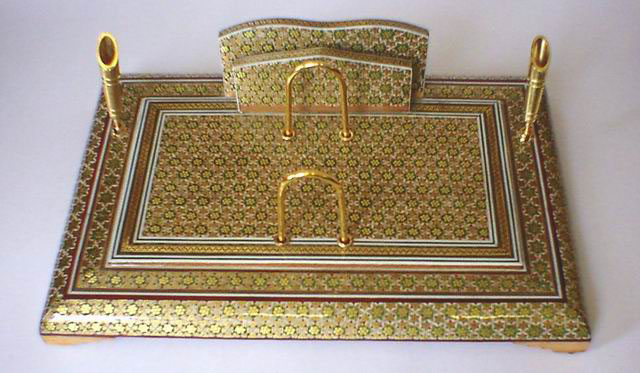Isfahan Khatam
(1).jpg)
Khatam (Persian: خاتم) is a Persian version of marquetry, art forms made by decorating the surface of wooden articles with delicate pieces of wood, bone and metal precisely-cut geometrical shapes. Khatam is also the capital of Khatam County in Iran. Khatam kari (Persian: خاتمکاری) is the art of crafting a Khatam. Common materials used in the construction of inlaid articles are gold, silver, brass, aluminum and twisted wire. Artworks with smaller inlaid pieces are generally more highly valued.
Designing of inlaid articles is a highly elaborate process. In each cubic centimeter of inlaid work, up to approximately 250 pieces of metal, bone, ivory and wood are laid side by side. Inlaid articles in the Safavid dynasty took on a special significance as artists created their precious artworks. These works include; doors and windows, mirror frames, Quran boxes, inlaid boxes, pen and penholders, lanterns and inlaid ornamented shrines.
The steps of making Khatam: First different kind of wood in different colors are provided and then with the relevant tools they are cut each horing 30 cm length and 1-5.2 mm diameter and some triangles are prepared from them, which after filing, all the lateral are made according to the plan and as desirable and in order to finish the plan,there is a need for metal wires which some steps are taken to prepare them. Then to make Khatam the head-artisian draws the drawings of different figures which are to be made in order to make Khatam and these wooden triangles or metal ones are put beside each other by the hands of skillful artist and glued to each other and made firm with the use of strings of which made called paddle( expression) After some hours the strings are filed and four paddles which hare been made are put beside each other and then are glued to each other again resulting in something called "toglo" the next steps which is popular as making flowers is initiated. In this step, 6 wires are glued around each corner by a round metal wire which is made in six lateral figure and called shamse, and then the resulting structure is firmed by strings which a star-like plan is obtained, these plans are so repeated that the required general plan is made and put under pressure of press machine and Khatam is made after some steps of cutting and gluing the very delicate layers to each other that all of these steps from the beginning up to the end consists of 400 operational steps. The Khaatam are glued based on the plan, color, shape, dimensions and the place of application and by making different plans and making similar figures or symmetrical shapes, all the plan surface is adorned by signets which is then prepared by performing some repairs, filing, brushing and under cuttings and finally grinding and straightening of Khatam surface, and then oiling and polishing by some special materials such as sealer and polisher. The quality of a Khatam depends on its fine drawing and regularity of the plan, all of which are summarized in the skills of head artisian.

The ornamentation of the doors of holy places predominantly consists of inlaid motifs. Samples of these can be observed in the cities of Mahshad, Qom, Shiraz and Rey. In the Safavid era, the art of marquetry flourished in the southern cities of Iran, especially in Isfahan, Shiraz and Kerman. An inlaid desk, which is one of the definitive masterpieces of this art, was awarded the first prize and a gold medal in an art exposition in Brussels recently[citation needed]. This desk is now preserved in the National Museum in Washington[citation needed]. Also in some of the Majestic places and homes, doors and various items have been inlaid. The inlaid-ornamented rooms at Saadabad Palace and Marble Palace in Tehran are among masterpieces of this art.
Currently this art is being practiced in Isfahan, Shiraz and Tehran. Inlay masters, preserving the nobility of their art, have brought forth great innovations in this fine art. Woodcarving is one of the other outstanding Iranian arts. Designing has a special role in this skill. In wood-carving, magnificent patterns inlaid in wood, ivory or bone, with simple or protruded shapes are created.
One of the top masters in this art is Mohammad Bagher Hakim-Elahi (محمد باقر حكيم الهي). He learned the art of Khatam in his youth in Shiraz, Iran, from Master Sanee-Khatam, and thought it to his youngest brother, Asad-ol-lah Hakim-Elahi (اسد الله حكيم الهي). In early 1950s, Mr. Hakim-Elahi migrated to Tehran, where he lived until the end of his life in March 2012. During his life he created numerous Khatan art work, ranging from small frames, and jewelry boxes, to large items such as coffee tables, and large chandeliers, some of which are currently in Museums in Iran, but most are in private collection all around the world.
Important wood carving of Iran can be found in mosques, palaces and ancient buildings. Some of the Iranian inlaid works are preserved in museums inside or outside Iran . The usual images are rose leaves and drawings of birds and animals. Latticed woodwork is another art, which is made by hand. Old latticed doors and windows of Iran are famous. Among other artworks sudorific inlaid work can be mentioned. In this kind of inlaid work, the artist strictly avoids protrusions on the surface of the wood. The images cut out of natural wood in various colors are finely inlaid in the wooden outline. After the application of a fine finish, an even surface is portrayed, which tend to produce an interesting image of trees, flowers and animals. The art of inlaid and sudorific woodwork is supported by the workshops of the Cultural Heritage Organization of Iran. These arts are also practiced in private workshops.
.....
.....
.....

.jpg)



























